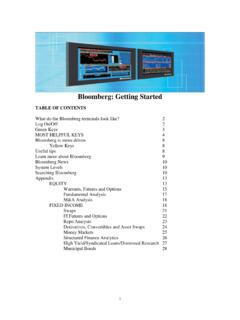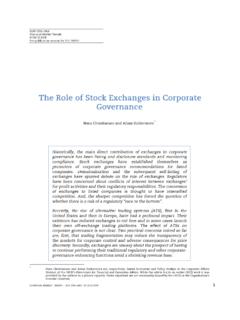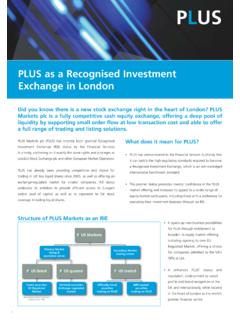Transcription of Metal Trading at the London Metal Exchange
1 M LARDALEN UNIVERSITY Department of Mathematics and Physics (IMA) MVH12, Analytical Finance I Metal Trading at the London Metal Exchange Martin Sj berg 780215 Table of Contents 1. The London Metal The History of 2. Market Prompt 3-Month Official prices and the second Forward price spreads: Forward price spreads: Carries: Borrowing and 3. The Copper 4. 1. The London Metal Exchange The London Metal Exchange (LME) is one of the leading international commodity, futures and options exchanges. It specialises in non-ferrous metals such as Copper, Primary Aluminium, Lead, Zinc, Nickel, Tin and Aluminium Alloy. The LME accounts for about 95% of global Exchange business for the metals it trades.
2 All contracts on the Exchange are priced in USD, but they can also be cleared in three other currencies; euro, Japanese yen and Sterling. Only members of the LME can buy or sell futures and options on the Exchange . The LME market operates on a principal basis whereby LME broker firms trade with themselves on behalf of their clients. There are currently three different ways to trade on the LME: - Open outcry market ( ring Trading ): Ring Trading is so called because the LME uses a ring with the traders sitting at fixed points around the circle. Trading activities takes place throughout the day with each LME contract traded in specific five minutes periods known as rings . At present there are 11 ring dealers and all business, which is required to be dealt across the floor, must be passed through a ring-dealing member.
3 A significant proportion of all LME contracts are traded in the ring sessions, especially the second morning ring where the official prices are set, but more about that later on. The ring itself is about 6m in diameter, with two large display boards above it showing the official prices. There is a special both where the Exchange s staff monitor the prices and input bids, offers, spreads and trades made into a computer system. This is instantly sent to various newsvendor services that display LME prices ( Reuters and Bloomberg). Behind each firm s ring seat is a place for assistants to stand in order to pass orders into the ring and to give commentaries to customers about current market conditions. Picture 1. The LME ring seen from above.
4 1- Telephone market: The ring offers benefits of transparency attached to a physical, open marketplace, but it is only available for a part of the working day. To cover the whole 24-hour day an inter-office telephone market is used. This is a system like a foreign Exchange , bond or stock market, but then clears like a ring-traded contract. In other words, people can see an indicative price on a screen as they contact a broker, and then complete a deal there and then. Brokers continue to provide indicative prices through vendor screens. The actual prices quoted to a prospective client by a broker may not be identical to the indicative prices, but will depend on the size of the deal, the state of the market and on the client s credit rating and relationship with the broker.
5 - LME Screen Trading System ( LME Select ): LME select is the official Exchange operated Trading platform, available in addition to open outcry ring Trading and the telephone market. Member firms are connected to the system which allows accredited traders to execute trades electronically. The system allows Trading on all LME contracts, futures and options. It also allows straight through processing whereby LME Select trades will automatically be sent to the matching and clearing systems. The History of LME The origin of the LME can only be traced back as far as the opening of the Royal Exchange in London in 1571. It was there that traders in Metal and a range of other commodities began to meet on a regular basis.
6 In the early 19th century there were so many commodity traders, ship characters and financers using the Royal Exchange that it became impossible to do business and individual groups of traders set up shop in the nearby city coffee houses. The Jerusalem Coffee House of Cornhill became a favourite of the Metal Trading community, and it was there the tradition of the Ring was born. A merchant with Metal to sell would simply draw a circle on the dusty floor and call out change at which point all those whishing to trade would assemble around the circle and make their bids. In the early part of the 19th century the was self sufficient in copper and tin. However, with the advent of the industrial revolution the needed to import large tonnage s from abroad.
7 The Metal traders were now faced with a real problem because, having bought for example copper concentrates from Chile or tin from Malaysia, they had no way of knowing what the price would be at the time of the ships arrival months later. The import of large quantities from overseas at irregular intervals put merchants and consumers under serious risk. But with new inventions like the telegraph and steam ships the arrival dates of the gods was much more easy to predict. Now merchants were able to sell a cargo of Metal forward for delivery on a fixed date, thus protecting themselves against a fall in price during the voyage. This was the start of the LME future s market. As delivery tonnages grew to meet the increasing demands of the industry, more and more merchants were attracted to the Metal Trading .
8 New metals have been introduced as 2demand dictated. Copper and tin have been traded on the LME since the beginning, although with upgraded contracts. Lead and zinc were officially introduced in 1920, but were traded unofficially before that. Primary aluminium was introduced in 1978 and was followed by nickel one year later. Aluminium alloy was introduced in October 1992. In the beginning of 2005 two different plastic contracts were introduced, and it looks likely that a steel contract as well as a pulp contract will be presented in the near future. Over the years the LME has moved between different addresses in London , but since 1994 the LME is located at Leadenhall Street, not far from the Banks tube station. 32.
9 Market Terms There are a number of expressions that are used everyday in the Metal Trading industry. Several terms and market rules have a long history and were based on market conditions during the 19th century. Here are some of the most used terms: Warrants Delivery of LME contracts is in the form of warrants that are bearer documents of title. Each warrant entitles to take position of one lot of Metal at a specific LME warehouse. Lot A lot is the minimum amount of a commodity in which one may deal on a futures market. The lot sizes at LME are as follows: Aluminium, Copper, Zinc 25 metric tonnes Aluminium alloy 20 metric tonnes Nickel 6 metric tonnes Tin 5 metric tonnes Buy/Sell Naturally, Buy means to buy a contract and Sell means to sell a contract.
10 However, it is worth mentioning that the English terms Buy/Sell are the only one allowed. Although there are several brokers with multi language skills you can t for example use the Swedish terms K p/S lj . The reason for this is to avoid misunderstandings. In some languages the terms for Buy and Sell sound alike, in German where Buy is Kaufen and Sell is Verkaufen , so a small disturbance on the telephone line could end up to be very expensive for some part. In the telephone market all deals and conversations between the brokers and their clients are recorded. Prompt date The prompt, or delivery date is the date on which the Metal has to be delivered to fulfil the contract terms. However, the major part of all contracts is closed before the prompt date so there is no physical flow of Metal .









